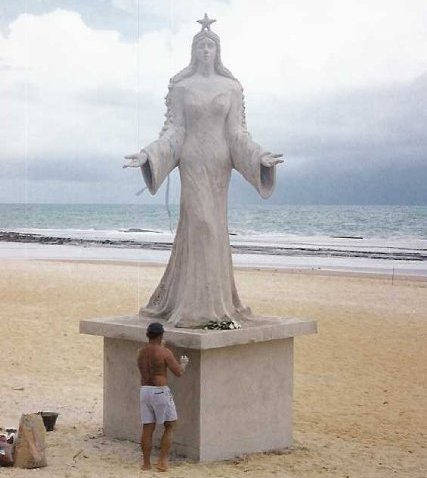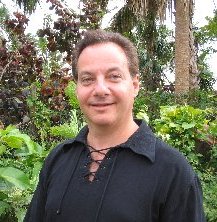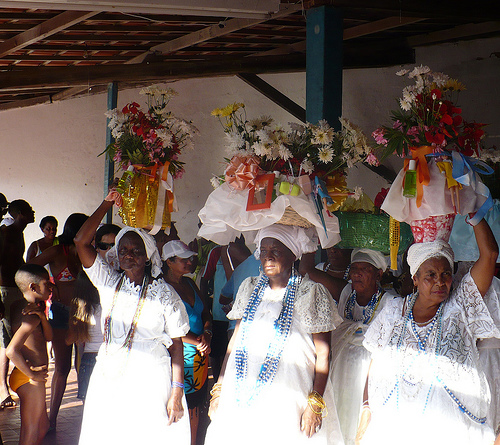Welcome, 2014! The calendar New Year may be the only holiday celebration that nearly the entire world experiences or collectively recognizes. Despite this universality, our New Year’s traditions are as diverse as our world cultures. Therefore this unique period of time offers the opportunity to witness and compare foreign practices that have a similar meaning and purpose to our own. This includes cultural traditions that are not normally in the global spotlight.
Such is the case with two New Year’s celebrations that have very clear esoteric foundations: Brazil’s Festa de Iemanjá and Cuba’s ceremony dedicated to Eshu-Elegbara. Both are products of regional African-based religions: Candomblé and Umbanda (Brazil) or Lukumi (Cuba).

Iemanja on a Brazilian beach. The man is performing a New Year’s tribute to the Sea Goddess. (Photo courtesy of Link)
Festa de Iemanjá
Over the years, Brazil’s Festa de Iemanjá has become a major secular tradition – one that attracts tourists from around the world. On New Year’s Eve, thousands of locals dress all in white and head to Rio de Janeiro’s beaches in order to honor the Goddess Iemanjá. Images of the Sea Goddess are everywhere as participants throw roses or gifts into the water and feast on the beach. In addition, they “jump 7 waves” to wash away negativity while making wishes for the New Year.
Link, an American Pagan who has lived and worked extensively in Brazil, compares this love of Iemanjá to the American devotion to Santa Claus. He says:
You can probably find roots to Pagan Scandinavia, but [Santa] is permanently engraved in the secular celebrations of the holiday… Those two ideas are totally separate. And thus is Iemanjá — prime deity of a very esoteric culture, as well as a part of every common person’s New Years Eve. Pour Champagne into the ocean? For Iemanjá!

Link
This esoteric culture is that of Candomblé and Umbanda, two syncretic religions which developed out of the West African Yoruba religion. After finding its way to the Americas by way of the slave trade, the West African spiritual system merged with Catholicism. Like other syncretic religions, Candomblé and Umbanda now thrive as distinct minority faiths.
Within these traditions, Iemanjá is called an Orixa, not Goddess, and is considered a primary deity. Despite the secular appropriation of the Festa de Iemanjá, the practitioners of Candomblé and Umbanda continue to honor her in their own religious ways. While living in Brazil, Link was fortunate enough to attend a private Candomblé Iemanjá ritual. He recalls:
I asked a few questions about the ritual when I got there, and one guy said “I don’t know.” Another guy said “I don’t know – ask him,” pointing to another man. That man told me. “Tudo aqui e segredo.” Everything here is secret. After that, I stopped asking questions and just enjoyed the evening. It was a valuable lesson … Understanding is very rational, but religious experiences are just that – experiences. Rational thinking can limit the experience sometimes.
Despite the secular popularity of Iemanjá, both Candomblé and Umbanda practitioners are still largely marginalized. However, times are changing. Denise de Santi, president of IBWB church of Wicca and Witchcraft in Brazil, notes that although “Brazilian Witches and African Traditions do not mix,” we often stand together in defense of religious equality.

A Feb 2nd processional devoted to Iemanja (Photo Couresty of Flickr’s Sabrina Gledhill)
Iemanjá may actually be helping. In regions where Candomblé and Umbanda are strongly rooted, Iemanjá festivals are most popular. In Bahia the festivities are held Feb. 2, and, in Sao Paolo, they happen in early December. However, the Rio New Year’s celebration gets the most “press.” This year, news reports are stating that participation was up by 15,000 people. Moreover, the Rio Festa de Iemanjá was reportedly broadcast in Latin America and the United States for the first time via the Fox network.
The growing popularity of all of these festivals, secular or not, does call attention to these minority religions, highlighting their very real presence in Brazil. Does the secularization of their Orixa ultimately help or hinder their spiritual work? That is a discussion for another day.
Eshu-Elegbara
Unlike the Festa de Iemanjá, the Cuban New Year’s ceremony has not been co-opted by secular culture. It is strictly a public religious ritual for those practicing Lukumi, more often called Santeria, another syncretic religion based on the West African Yoruba traditions and Catholicism. As reported by The Associated Press:
About 200 believers and onlookers thronged Havana’s most important market, Cuatro Caminos, for the ceremony dedicated to Eshu Elegbara… In a central courtyard at the market, people sprayed rum from their mouths at a 2 foot tall cement stone statue of Eshu Elegbara… At its base, they left offerings of coconut, watermelon, candy and flowers.
The article goes on to say that this was the first year that market administrators allowed the religious statue to be permanently erected after 18 years of practice. American Stacey Lawless, an aborisha (practitioner) of Lukumi, said:
I’m glad the Ocha community got permission to build the Eshu-Elegbara shrine at Cuatro Caminos. The shrine looks cool itself. I think it’s important to stress that it is a shrine, not just a statue. That “icon” is actually an embodied manifestation — an avatar if you like — of the Orisha Elegbara. So now he’s present in the Cuatro Caminos market in a very material way.

Stacey Lawless
The administrators’ show of support has allowed the “Ocha community” to take a step forward in its own quest for greater global understanding and presence. As Jason reported yesterday, the Lukumi New Year’s tradition also includes a divination ritual performed by the babalawos, a specialized priesthood devoted to such practice. Their yearly predictions make international news.
With a shrinking world through the evolution and speed of mass media, we are able to witness these unique cultural practices and their New Year’s traditions. As attention is drawn to their rituals, to their Orixa, to their divinations and their people, attention is also drawn to their religions and their very real presence in our global society. In this way New Year’s celebrations, which are largely considered superficial, can also have a very profound purpose in the movement for social change.
(Important Note: Photos of the Eshu-Elegbara ceremony are under AP copyright. To see them, please click on the link to see a slide show of these engaging photos.)
The Wild Hunt is not responsible for links to external content.
To join a conversation on this post:
Visit our The Wild Hunt subreddit! Point your favorite browser to https://www.reddit.com/r/The_Wild_Hunt_News/, then click “JOIN”. Make sure to click the bell, too, to be notified of new articles posted to our subreddit.
Fascinating stuff; I learned quite a bit. Thank you.
Denise de Santi, president of IBWB church of Wicca and Witchcraft in Brazil, notes that although “Brazilian Witches and African Traditions do not mix,” we often stand together in defense of religious equality.
I love that sentiment!
I’ve been making offerings to Iemanja almost every Jan 1 for over 20 years. Thank you for this article. Odò Iyá!
Thank you for posting this article – so good!
These festivals sound really amazing! Thanks for bringing them to our attention.